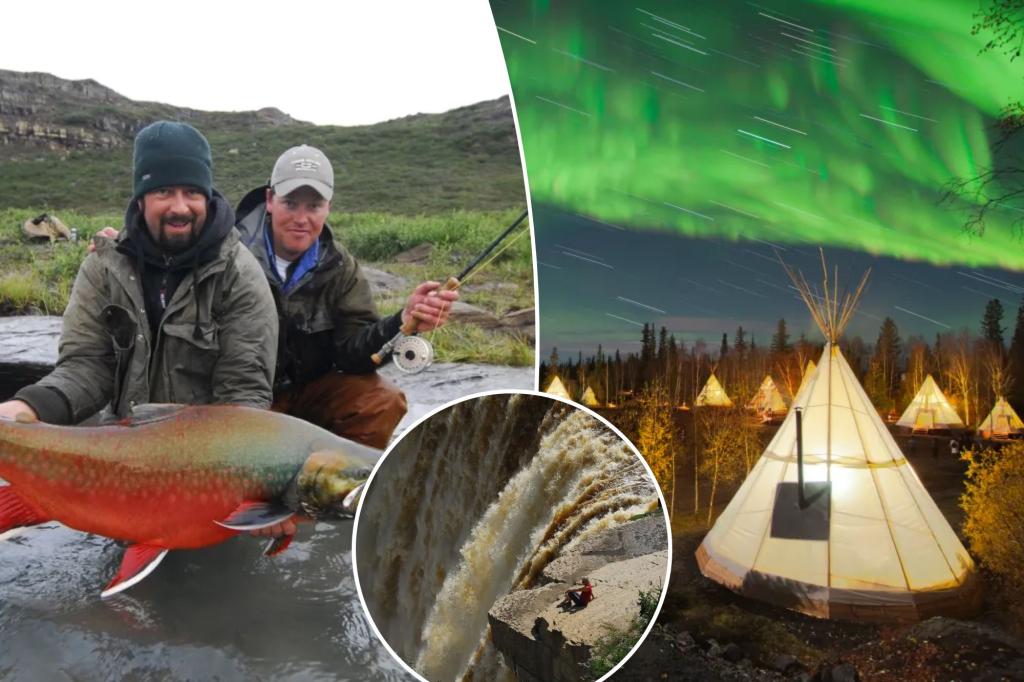With a waterfall twice the height of Niagara, the longest remote hiking trail in North America, and a population of just 44,000, the Northwest Territories is a land of wild extremes.
Most travelers who make it to this vast tundra, more than two-and-a-half times the size of California with 10 times more caribou than people, are following the light.
Situated right under the Earth’s band of maximal auroral activity, it shines with 240 nights of nature’s answer to an ’80s rock laser show. But once they’ve arrived, they tend to stay.
“The abundance of the land stands unique in an increasingly industrialized North America,” said Joel Hibbard, a second-generation river guide and co-owner of Nahanni River Adventures. “Vibrant culture and a landscape that bears the marks of the last ice age set the stage for an experience found nowhere else on earth.”
Wondering where to start? We’ve got you covered.
City of gold
All roads in the Northwest Territories lead to Yellowknife, whether you’re heading onward to the arctic or chasing the aurora across the horizon.
“Due to its gold-mining history, people might picture one of those remote Wild West towns with one main street and a couple of cabins,” said Tyler Abela, marketing director of Northwest Territories Tourism.
Yet Yellowknife offers plenty to see and do from browsing museums packed with artifacts and dining on fresh-caught cod at Bullock’s Bistro to exploring Houseboat Bay, a one-of-a-kind community. There’s even a Tim Hortons.
Aurora explora
If the aurora eluded you in Iceland, Greenland and Norway, it’s time to head to the Northwest Territories where, statistically speaking, luck should favor you.
“We have no mountains and no oceans, which create an unstable, cloudy weather system,” said Joe Bailey, owner of North Star Adventures. “That equals more clear nights than any other aurora country in the world.”
Increase your odds even further by joining Bailey, who earned the nickname “Aurora Hunter” for his natural ability to track the phenomenon using indigenous knowledge and technology. “We drive 60, 70, maybe 100 miles to find clear sky and the aurora. We have all the latest apps, but sometimes my gut will just tell me to go west and there it is.”
Vibe tribe
A little over half of the NWT’s population hail from 33 indigenous communities. Purchase locally made crafts like jewelry and tundra-proof mitts and attend a cultural demonstration of traditions like drumming, dancing, and canoe races. One of the best ways to learn about the area’s native heritage is by hiring an Indigenous-owned tour company.
“That way you’re not just going hiking or ice fishing,” said Donna Lee Demarcke, CEO of Northwest Territories Tourism.. “You’re gaining insight into what the activity means to their culture.”
Traveling with an Indigenous-operated business also helps you make authentic connections. “In the summer, we go boating in the Arctic Ocean and eat muktuk with the Inuits,” said Bailey. “It’s not for tourism — they’re practicing their culture.”
Catch all
Here be monsters: The NWT is home to numerous record-breaking lakes, including Great Slave, where the bottom marks the lowest natural point of North America, and Great Bear, the largest lake in Canada. Patrolling these depths are line-busting, bad-tempered northern pike and trout the size of 40- to 80-pound children.
“The fishing up here is absolutely endless,” said Demarcke. “There are hundreds of lakes across the territory. Not only are the fish large, but they’re plentiful and accessible.”
Wild, wild West
There are six national parks to choose from — including Nááts’ihch’oh (meaning “the mountain that’s sharp like a porcupine”). It’s so immense and new, hikers can still help map routes that will become the official trail network.
Be sure to canoe or raft the Nahanni, arguably Canada’s most famous and epic river.
“The Nahanni appeals to those with a curiosity for other ways of life and a desire to immerse themselves in Canada’s natural and cultural history and experience some of the finest untouched wilderness left on earth,” said Hibbard. “A trip on the Nahanni is a journey through the most visually diverse place on earth in a protected area larger than the country of Belgium. With Canada’s deepest canyons, it is a landscape that defies the imagination.”
Read the full article here

